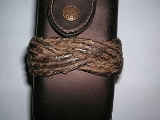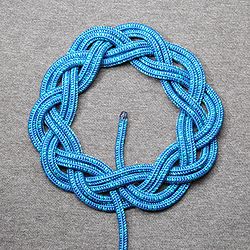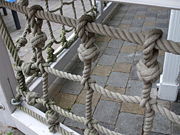
Turk's head knot
Encyclopedia
A Turk's head knot is a decorative knot
with a variable number of interwoven strands, forming a closed loop. The name is used to describe the general family of all such knots rather than one individual knot. While generally seen made around a cylinder
, the knot can also be deformed into a flat, mat-like shape. Some variants can be arranged into a roughly spherical shape, akin to a monkey's fist
knot.
The knot is used primarily for decoration and occasionally as anti-chafing protection. A notable practical use for the Turk's head is to mark the "king spoke" of a ship's wheel
; when this spoke
is upright the rudder
is in a central position. The knot takes its name from a notional resemblance to a turban
, though a turban is wound rather than interwoven
.
The Turk's head knot is used as a woggle
by Scout Leader
s who completed their training course and were thus award
ed with the Wood Badge
insignia
.
 Each type of Turk's head knot is classified according to the number of leads and bight
Each type of Turk's head knot is classified according to the number of leads and bight
s and method of construction. The number of bights is the number of crossings it makes as it goes around the circumference of the cylinder. The number of leads is the number of strands around the circumference of the cylinder, before doubling, tripling, etc. Depending on the number of leads and bights, a Turk's head may be tied using a single strand or multiple strands. Mathematically, the number of strands is the greatest common divisor
of the number of leads and the number of bights; the knot may be tied with a single strand if and only if
the two numbers are coprime
. For example, 3 lead × 5 bight (3×5), or 5 lead × 7 bight (5×7).
 There are three groupings of Turk's head knots.
There are three groupings of Turk's head knots.
Knot
A knot is a method of fastening or securing linear material such as rope by tying or interweaving. It may consist of a length of one or several segments of rope, string, webbing, twine, strap, or even chain interwoven such that the line can bind to itself or to some other object—the "load"...
with a variable number of interwoven strands, forming a closed loop. The name is used to describe the general family of all such knots rather than one individual knot. While generally seen made around a cylinder
Cylinder (geometry)
A cylinder is one of the most basic curvilinear geometric shapes, the surface formed by the points at a fixed distance from a given line segment, the axis of the cylinder. The solid enclosed by this surface and by two planes perpendicular to the axis is also called a cylinder...
, the knot can also be deformed into a flat, mat-like shape. Some variants can be arranged into a roughly spherical shape, akin to a monkey's fist
Monkey's fist
A monkey's fist or monkey paw is a type of knot, so named because it looks somewhat like a small bunched fist/paw. It is tied at the end of a rope to serve as a weight, making it easier to throw, and also as an ornamental knot. This type of weighted rope can be used as an improvised weapon,...
knot.
The knot is used primarily for decoration and occasionally as anti-chafing protection. A notable practical use for the Turk's head is to mark the "king spoke" of a ship's wheel
Ship's wheel
A ship's wheel is the modern method of adjusting the angle of a boat or ship's rudder in order to cause the vessel to change its course. Together with the rest of the steering mechanism it forms part of the helm. It is typically connected to a mechanical, electric servo, or hydraulic system...
; when this spoke
Spoke
A spoke is one of some number of rods radiating from the center of a wheel , connecting the hub with the round traction surface....
is upright the rudder
Rudder
A rudder is a device used to steer a ship, boat, submarine, hovercraft, aircraft or other conveyance that moves through a medium . On an aircraft the rudder is used primarily to counter adverse yaw and p-factor and is not the primary control used to turn the airplane...
is in a central position. The knot takes its name from a notional resemblance to a turban
Turban
In English, Turban refers to several types of headwear popularly worn in the Middle East, North Africa, Punjab, Jamaica and Southwest Asia. A commonly used synonym is Pagri, the Indian word for turban.-Styles:...
, though a turban is wound rather than interwoven
Weaving
Weaving is a method of fabric production in which two distinct sets of yarns or threads are interlaced at right angles to form a fabric or cloth. The other methods are knitting, lace making and felting. The longitudinal threads are called the warp and the lateral threads are the weft or filling...
.
The Turk's head knot is used as a woggle
Woggle
A woggle is a device to fasten the neckerchief, or scarf, worn as part of the Scout or Girl Guides uniform.-Origins of the woggle:Early Scouts tied a knot in their neckerchief to fasten it around the neck...
by Scout Leader
Scout Leader
A Scout Leader or Scouter generally refers to the trained adult leader of a Scout unit. The terms used vary from country to country, over time, and with the type of unit.-Roles:...
s who completed their training course and were thus award
Award
An award is something given to a person or a group of people to recognize excellence in a certain field; a certificate of excellence. Awards are often signifiedby trophies, titles, certificates, commemorative plaques, medals, badges, pins, or ribbons...
ed with the Wood Badge
Wood Badge
Wood Badge is a Scouting leadership program and the related award for adult leaders in the programs of Scout associations throughout the world. Wood Badge courses aim to make Scouters better leaders by teaching advanced leadership skills, and by creating a bond and commitment to the Scout movement...
insignia
Insignia
Insignia or insigne pl -nia or -nias : a symbol or token of personal power, status or office, or of an official body of government or jurisdiction...
.
Leads and bights

Bight (knot)
In knot tying, a bight is a curved section, slack part, or loop between the two ends of a rope, string, or yarn. The term is also used in a more specific way when describing Turk's head knots, indicating how many repetitions of braiding are made in the circuit of a given knot.-Slipped knot:In order...
s and method of construction. The number of bights is the number of crossings it makes as it goes around the circumference of the cylinder. The number of leads is the number of strands around the circumference of the cylinder, before doubling, tripling, etc. Depending on the number of leads and bights, a Turk's head may be tied using a single strand or multiple strands. Mathematically, the number of strands is the greatest common divisor
Greatest common divisor
In mathematics, the greatest common divisor , also known as the greatest common factor , or highest common factor , of two or more non-zero integers, is the largest positive integer that divides the numbers without a remainder.For example, the GCD of 8 and 12 is 4.This notion can be extended to...
of the number of leads and the number of bights; the knot may be tied with a single strand if and only if
If and only if
In logic and related fields such as mathematics and philosophy, if and only if is a biconditional logical connective between statements....
the two numbers are coprime
Coprime
In number theory, a branch of mathematics, two integers a and b are said to be coprime or relatively prime if the only positive integer that evenly divides both of them is 1. This is the same thing as their greatest common divisor being 1...
. For example, 3 lead × 5 bight (3×5), or 5 lead × 7 bight (5×7).

- Narrow, where the number of leads is two or more less than the number of bights (3×5, or 3×7),
- Wide, where the number of leads is two or more than the number of bights (5×3, or 16×7), and
- Square, where there is only a difference of one between leads and bights (7×8 or 8×7).

